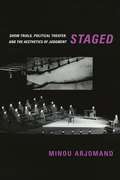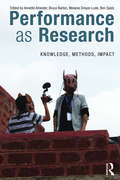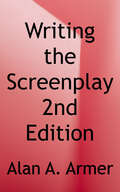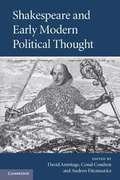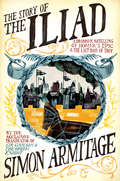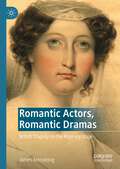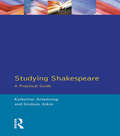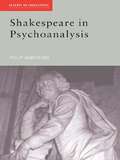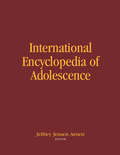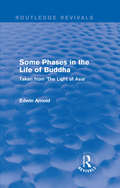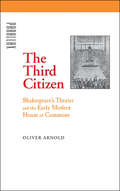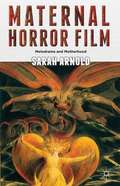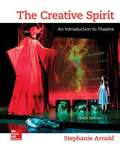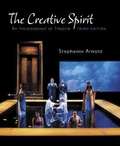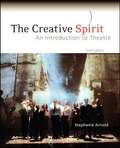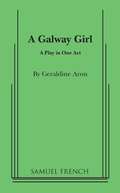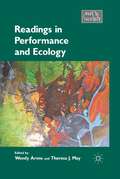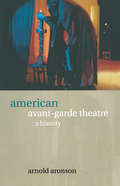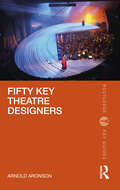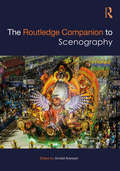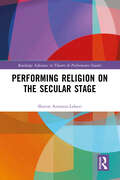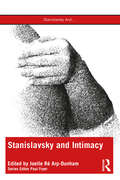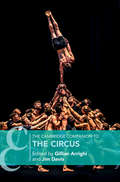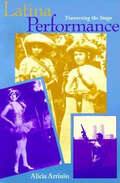- Table View
- List View
Staged: Show Trials, Political Theater, and the Aesthetics of Judgment
by Minou ArjomandTheater requires artifice, justice demands truth. Are these demands as irreconcilable as the pejorative term “show trials” suggests? After the Second World War, canonical directors and playwrights sought to claim a new public role for theater by restaging the era’s great trials as shows. The Nuremberg trials, the Eichmann trial, and the Auschwitz trials were all performed multiple times, first in courts and then in theaters. Does justice require both courtrooms and stages?In Staged, Minou Arjomand draws on a rich archive of postwar German and American rehearsals and performances to reveal how theater can become a place for forms of storytelling and judgment that are inadmissible in a court of law but indispensable for public life. She unveils the affinities between dramatists like Bertolt Brecht, Erwin Piscator, and Peter Weiss and philosophers such as Hannah Arendt and Walter Benjamin, showing how they responded to the rise of fascism with a new politics of performance. Linking performance with theories of aesthetics, history, and politics, Arjomand argues that it is not subject matter that makes theater political but rather the act of judging a performance in the company of others. Staged weaves together theater history and political philosophy into a powerful and timely case for the importance of theaters as public institutions.
Performance as Research: Knowledge, methods, impact
by Annette Arlander Bruce Barton Melanie Dreyer-Lude Ben SpatzPerformance as Research (PAR) is characterised by an extraordinary elasticity and interdisciplinary drive. Performance as Research: Knowledge, Methods, Impact celebrates this energy, bringing together chapters from a wide range of disciplines and eight different countries. This volume focuses explicitly on three critical, often contentious themes that run through much discussion of PaR as a discipline: Knowledge - the areas and manners in which performance can generate knowledge Methods - methods and methodologies for approaching performance as research Impact - a broad understanding of the impact of this form of research These themes are framed by four essays from the book's editors, contextualising their interrelated conversations, teasing out common threads, and exploring the new questions that the contributions pose to the field of performance. As both an intervention into and extension of current debates, this is a vital collection for any reader concerned with the value and legitimacy of performance as research.
Writing the Screenplay: TV and Film
by Alan A. ArmerIn this new edition, Emmy - Award winner Alan Armer takes aspiring writers through the essential steps needed to create successful dramatic scripts for TV and Film: visual thinking characters and plotting, story structure and conflict, dialog, and formats.
Shakespeare and Early Modern Political Thought
by David Armitage Conal Condren Andrew FitzmauriceThis is the first collaborative volume to place Shakespeare's works within the landscape of early modern political thought. Until recently, literary scholars have not generally treated Shakespeare as a participant in the political thought of his time, unlike his contemporaries Ben Jonson, Edmund Spenser and Philip Sidney. At the same time, historians of political thought have rarely turned their attention to major works of poetry and drama. A distinguished international and interdisciplinary team of contributors examines the full range of Shakespeare's writings in order to challenge conventional interpretations of plays central to the canon, such as Hamlet; open up novel perspectives on works rarely considered to be political, such as the Sonnets; and focus on those that have been largely neglected, such as The Merry Wives of Windsor. The result is a coherent and challenging portrait of Shakespeare's distinctive engagement with the characteristic questions of early modern political thought.
The Story of the Iliad: A Dramatic Retelling of Homer’s Epic and the Last Days of Troy
by Simon ArmitageAward-winning poet Simon Armitage dramatizes the story of Troy, animating this classic epic for a new generation of readers. Following his highly acclaimed dramatization of the Odyssey, Simon Armitage here takes on the fate of Troy, bringing Homer's Iliad to life with refreshing imaginative vision. In the final days of the Trojan War, the Trojans and the Greeks are caught in a bitter stalemate. Exhausted and desperate after ten years of warfare, gods and men battle among themselves for the glory of recognition and a hand in victory. Cleverly intertwining the Iliad and the Aeneid, Armitage poetically narrates the tale of Troy to its dire end, evoking a world plagued by deceit, conflict, and a deadly predilection for pride and envy. As with the Odyssey, Armitage reveals the echoes of ancient myth in our contemporary war-torn landscape, and reinvigorates the classic epics with adventure, passion, and, surprisingly, Shakespearean wit.
Romantic Actors, Romantic Dramas: British Tragedy on the Regency Stage
by James ArmstrongThis book reinterprets British dramas of the early-nineteenth century through the lens of the star actors for whom they were written. Unlike most playwrights of previous generations, the writers of British Romantic dramas generally did not work in the theatre themselves. However, they closely followed the careers of star performers. Even when they did not directly know actors, they had what media theorists have dubbed "para-social interactions" with those stars, interacting with them through the mediation of mass communication, whether as audience members, newspaper and memoir readers, or consumers of prints, porcelain miniatures, and other manifestations of "fan" culture. This study takes an in-depth look at four pairs of performers and playwrights: Sarah Siddons and Joanna Baillie, Julia Glover and Samuel Taylor Coleridge, Edmund Kean and Lord Byron, and Eliza O'Neill and Percy Bysshe Shelley. These charismatic performers, knowingly or not, helped to guide the development of a character-based theatre—from the emotion-dominated plays made popular by Baillie to the pinnacle of Romantic drama under Shelley. They shepherded in a new style of writing that had verbal sophistication and engaged meaningfully with the moral issues of the day. They helped to create not just new modes of acting, but new ways of writing that could make use of their extraordinary talents.
Studying Shakespeare: A Practical Introduction
by Katherine Armstrong Graham AtkinThis book is a concise single volume guide to studying Shakespeare, covering practical as well as theoretical issues. The text deals with the major topics on a chapter-by-chapter basis, starting with why we study Shakespeare, through Shakespeare and multimedia, to a final chapter on Shakespeare and Theory. Current trends and recent developments in Shakespearean studies are also discussed, with an emphasis on the contextualisation of Shakespeare, historical appropriations of his work and the debate concerning his place in the literary canon. Extensive reference is made to a variety of developing media, e.g. film, audio cassette, video, CD-Rom and global digital networks, bringing the study of Shakespeare into the twentieth century.
Shakespeare in Psychoanalysis (Accents on Shakespeare)
by Philip ArmstrongThe link between psychoanalysis as a mode of interpretation and Shakespeare's works is well known. But rather than merely putting Shakespeare on the couch, Philip Armstrong focuses on the complex and fascinatingly fruitful mutual relationship between Shakespeare's texts and psychoanalytic theory. He shows how the theories of Freud, Rank, Jones, Lacan, Erikson, and others are themselves in a large part the product of reading Shakespeare. Armstrong provides an introductory cultural history of the relationship between psychoanalytic concepts and Shakespearean texts. This is played out in a variety of expected and unexpected contexts, including: *the early modern stage *Hamlet and The Tempest *Freud's analytic session *the Parisian intellectual scene *Hollywood *the virtual space of the PC.
International Encyclopedia of Adolescence
by Jeffrey Jensen ArnettIn pre-industrial societies, people moved from childhood to adulthood directly, getting married and going to work early in life. Although this still holds true for many cultures, in countries such as the USA or Japan, adolescence has become a specific stage of life, where young people are cultural trendsetters and market drivers. The International Encyclopedia of Adolescence is an exhaustive socio-cultural survey of young people around the world. The focus is cultural and historical, and the work offers a rarely found worldwide perspective. Entries are compiled by experts from many fields of study, including anthropology, history, psychology, and sociology. Unlike existing works, the Encyclopedia does not stress biological or psycho-pathological issues. It addresses myths and realities of adolescence by looking at the actual life of young people in regions as varied as Iran, India, France, the USA, or Japan. It also explains how teen cultures have developed in some countries and how young people deal with the conflicts between tradition and modernity in others. Country coverage examines cultural beliefs, gender, personal and cultural identity, relationships (familial), friends and peers, love and sexuality, education, work, media, problems, and outlook for the future, plus topics particular to the culture or region discussed.
Routledge Revivals: Taken from 'The Light of Asia' (Routledge Revivals)
by Edwin ArnoldFirst published in 1915, this book presents a dramatization of part ofthe author's The Light of Asia. The original text represents one of the first successful attempts to popularise Buddhism and its founder Gautama Buddha — presenting his life, teachings and philosophy in verse poetry. This adaptation dramatizes part of the The Light of Asia and includes staging instructions, properties required, illustrative drawings of suggested costumes, and incidental music composed specifically for the piece. This book will be of interest to students of Indian and Buddhist literature — and how this has interacted with the West — as well as students of drama.
The Third Citizen: Shakespeare's Theater and the Early Modern House of Commons (Parallax: Re-visions of Culture and Society)
by Oliver ArnoldThe new practices and theories of parliamentary representation that emerged during Elizabeth's and James' reigns shattered the unity of human agency, redefined the nature of power, transformed the image of the body politic, and unsettled constructs and concepts as fundamental as the relation between presence and absence. In The Third Citizen, Oliver Arnold argues that recovering the formation of political representation as an effective ideology should radically change our understanding of early modern political culture, Shakespeare's political art, and the way Anglo-American critics, for whom representative democracy is second nature, construe both. In magisterial readings of Titus Andronicus, Julius Caesar, Coriolanus, and the First Tetralogy, Arnold discovers a new Shakespeare who was neither a conservative apologist for monarchy nor a prescient, liberal champion of the House of Commons but instead a radical thinker and artist who demystified the ideology of political representation in the moment of its first flowering. Shakespeare believed that political representation produced (and required for its reproduction) a new kind of subject and a new kind of subjectivity, and he fashioned a new kind of tragedy to represent the loss of power, the fall from dignity, the false consciousness, and the grief peculiar to the experiences of representing and of being represented. Representationalism and its subject mark the beginning of political modernity; Shakespeare’s tragedies greet political representationalism with skepticism, bleakness, and despair.
Maternal Horror Film
by Sarah ArnoldMaternal Horror Film: Melodrama and Motherhood examines the function of the mother figure in horror film. Using psychoanalytic film theory as well as comparisons with the melodrama film, Arnold investigates the polarized images of monstrous and sacrificing mother.
The Creative Spirit: An Introduction to Theatre
by Stephanie ArnoldFocusing on the collaborative process, The Creative Spirit 6e introduces students to theatre through the plays themselves and the playwrights, directors, actors, and designers who combine their talents to create the theatre event. The Creative Spirit provides a rich context for each play included, with a discussion of the playwright's biography and sources, historical and cultural timelines, and a case study of a particular production of the play so that students can experience theatre from the inside. All of the materials for a complete course are presented together in one volume.
The Creative Spirit: An Introduction to Theatre
by Stephanie ArnoldIncludes discussion of each playwright's other works, sources, timelines for historical and cultural context, and the production of the plays.
The Creative Spirit: An Introduction to Theatre
by Stephanie ArnoldFocusing on the collaborative and creative processes that go into productions, The Creative Spirit: An Introduction to Theatre introduces students to the theatre through the plays themselves and the people who write them, create them, and act in them. The book provides a rich context for each play with a discussion of the playwright's other works, sources for the play, timelines that present historical and cultural background, and a section on a particular production of the play to give students a sense of the theatre industry at close hand. The Creative Spirit includes complete scripts of five plays: August Wilson's Joe Turner's Come and Gone, Wakako Yamauchi's And the Soul Shall Dance, Tony Kushner's Angels in America, Milcha Sanchez-Scott's Dog Lady, and Nilo Cruz's Anna in the Tropics.
Dryden: An Essay of Dramatic Poesy
by Thomas Arnold William T. Arnold"Dryden’s Essay of Dramatic Poesy" provides a captivating exploration of the nature and principles of dramatic poetry in this influential work first published in 1668. The web page encompasses not only the titular essay but also features a comprehensive preface by Thomas Arnold, revised by William T. Arnold, offering historical and biographical context along with a summary and analysis of Dryden's key arguments. Dryden's Epistle Dedicatory, addressed to Charles Sackville, adds a personal touch, elucidating the essay's purpose and praising Sackville's contributions to the arts. The main body, "Essay of Dramatic Poesy," unfolds as a lively dialogue among four gentlemen, debating topics ranging from ancient versus modern poets to the rules of drama. Dryden's sharp wit and critical insight shine through with rich examples and references. The inclusion of Dryden's Defence of the Essay, responding to objections raised by Sir Robert Howard, provides a well-rounded perspective, defending his views on rhyme, verse, and dramatic unities with humor and courtesy. This compilation offers a profound glimpse into the world of dramatic poesy and Dryden's enduring literary prowess.
A Galway Girl
by Geraldine AronDrama / Characters:1 male, 1 femaleScenery: Interior. A couple sit at opposite ends of a table reminiscing about their life together. Each has a point of view and they rarely address each other directly. They are young to begin with, then middle aged, then old, then one dies. The anecdotes they relate are both humorous and tragic. Their lives seem wasted, yet the wife's muted final gesture of affection conveys a love that endured through years of bickering. A critical success in London, Ireland and the author's native South Africa. "A minute tapestry cross stitched with rich detail-- invested with a strong strain of uncomfortable truths."-- Irish Times.
Readings in Performance and Ecology
by Wendy Arons Theresa J. MayThis ground-breaking collection focuses on how theatre, dance, and other forms of performance are helping to transform our ecological values. Top scholars explore how familiar and new works of performance can help us recognize our reciprocal relationship with the natural world and how it helps us understand the way we are connected to the land.
American Avant-Garde Theatre: A History (Theatre Production Studies)
by Arnold AronsonThis stunning contribution to the field of theatre history is the first in-depth look at avant-garde theatre in the United States from the early 1950s to the 1990s. American Avant-Garde Theatre offers a definition of the avant-garde, and looks at its origins and theoretical foundations by examining: *Gertrude Stein *John Cage *The Beat writers *Avant-garde cinema *Abstract Expressionism *Minimalism There are fascinating discussions and illustrations of the productions of the Living Theatre, the Wooster Group, Open Theatre, Ontological-Hysteric Theatre and Performance Group. among many others. Aronson also examines why avant-garde theatre declined and virtually disappeared at the end of the twentieth century.
Fifty Key Theatre Designers (Routledge Key Guides)
by Arnold AronsonFifty Key Theatre Designers looks at the history of theatrical scenography by examining the work and contributions of fifty ground-breaking set, costume, lighting, and projection designers since the Renaissance. Developments of scenic design are traced from the introduction of perspective painting to create illusionistic scenery in Renaissance Italy to the use of digital projection in the twenty-first century. The book also discusses important landmarks in the evolution of costume and lighting design, as well as the introduction of film and video technology to stage design. A broad range of work is explored, including opera, dance, Broadway and West End commercial theatre, avant-garde performance, and even Olympic spectacles. Each chapter features one designer, including basic biographical information and a discussion of that artist’s style, aesthetics, and contributions. Designers covered include Sebastiano Serlio, Ferdinando Bibiena, Richard Wagner, Adolphe Appia, and Edward Gordon Craig, amongst many other notable individuals. Each chapter also includes references to other significant designers with similar aesthetics or who made similarly important contributions to the development of that aspect of scenography. This book is ideal for undergraduates and graduates of scenography, theatrical design, and theatre history.
The Routledge Companion to Scenography (Routledge Companions)
by Arnold AronsonThe Routledge Companion to Scenography is the largest and most comprehensive collection of original essays to survey the historical, conceptual, critical and theoretical aspects of this increasingly important aspect of theatre and performance studies. Editor and leading scholar Arnold Aronson brings together a uniquely valuable anthology of texts especially commissioned from across the discipline of theatre and performance studies. Establishing a stable terminology for a deeply contested term for the first time, this volume looks at scenography as the totality of all the visual, spatial and sensory aspects of performance. Tracing a line from Aristotle’s Poetics down to Brecht and Artaud and into contemporary immersive theatre and digital media, The Routledge Companion to Scenography is a vital addition to every theatre library.
Performing Religion on the Secular Stage (Routledge Advances in Theatre & Performance Studies)
by Sharon Aronson-LehaviThis book examines the relations between Western religion, secularism, and modern theater and performance. Sharon Aronson-Lehavi posits that the ongoing cultural power of religious texts, icons, and ideas on the one hand and the artistic freedom enabled by secularism and avant-garde experimentalism on the other, has led theatre artists throughout the twentieth century to create a uniquely modern theatrical hybrid–theater performances that simultaneously re-inscribe and grapple with religion and religious performativity. The book compares this phenomenon with medieval forms of religious theater and offers deep and original analyses of significant contemporary works ranging from plays and performances by August Strindberg, Hugo Ball (Dada), Jerzy Grotowski, and Hanoch Levin, to those created by Adrienne Kennedy, Rina Yerushalmi, Deb Margolin, Milo Rau, and Sarah Ruhl. The book analyzes a new and original historiography of a uniquely modern theatrical phenomenon, a study that is of high importance considering the reemergence of religion in contemporary culture and politics.
Stanislavsky and Intimacy (Stanislavsky And...)
by Arp-Dunham, Joelle RéStanislavsky and Intimacy is the first academic edited book with a focus on how intimacy protocols, choreography, and theories intersect with the broad practices of Konstantin Stanislavsky’s ‘system’. As the basis for most Western theatre and film acting, Stanislavsky’s system centers on truthful performances. Intimacy direction and choreography insists on not only a culture of consent, but also specific, repeatable choreography for all staged intimate moments. These two practices have often been placed as diametric opposites, but this book seeks to dispel this argument. Each chapter discusses specific Stanislavskian principles and practices as they relate to staged sexually intimate moments, also opening the conversation to the broader themes and practices of other kinds of intimacy within the acting field. Stanislavsky And... is a series of multi-perspectival collections that bring the enduring legacy of Stanislavskian actor training into the spotlight of contemporary performance culture, making them ideal for students, teachers, and scholars of acting, actor training, and directing.
The Cambridge Companion to the Circus (Cambridge Companions to Theatre and Performance)
by Gillian Arrighi Jim DavisThe Cambridge Companion to the Circus provides a complete guide for students, scholars, teachers, researchers, and practitioners who are seeking perspectives on the foundations and evolution of the modern circus, the contemporary extent of circus studies, and the specialised literature available to support further enquiries. The volume brings together an international group of established and emerging scholars working across the multi-disciplinary domain of circus studies to present a clear overview of the specialised histories, aesthetics and distinctive performances of the modern circus. In sixteen commissioned essays, it covers the origins in commercial equestrian performance during the late-eighteenth century to contemporary inflections of circus arts in major international festivals, educational environments, and social justice settings.
Latina Performance: Traversing the Stage
by Alicia Arrizon"Latina Performance is a densely theorized treatment of rich materials." —MultiCultural Review"Arrizón's important book revolves around the complex issues of identity formation and power relations for US women performers of Latin American descent." —ChoiceLatina Performance examines the Latina subject whose work as dramatist, actress, theorist, and/or critic further defines the field of theater and performance in the United States. Alicia Arrizón looks at the cultural politics that flows from the intersection of gender, ethnicity, race, class, and sexuality.
